There Are Three Ways to Read Any Text for Analysis
Introduction to textual analysis
Do you know how to read English texts for textual analysis? Reading a text is an essential part of studying English. Obviously, you tin can't write essays without reading and analysing your texts. Only where should you start with textual analysis?
In this Role of our Beginner's Guide to Acing HSC English, we volition give you a thorough explanation of textual analysis and how to read your texts and walk you through a step-by-stride procedure for creating flawless and insightful notes.
Download a free textual analysis planner to beginning writing insightful essays!
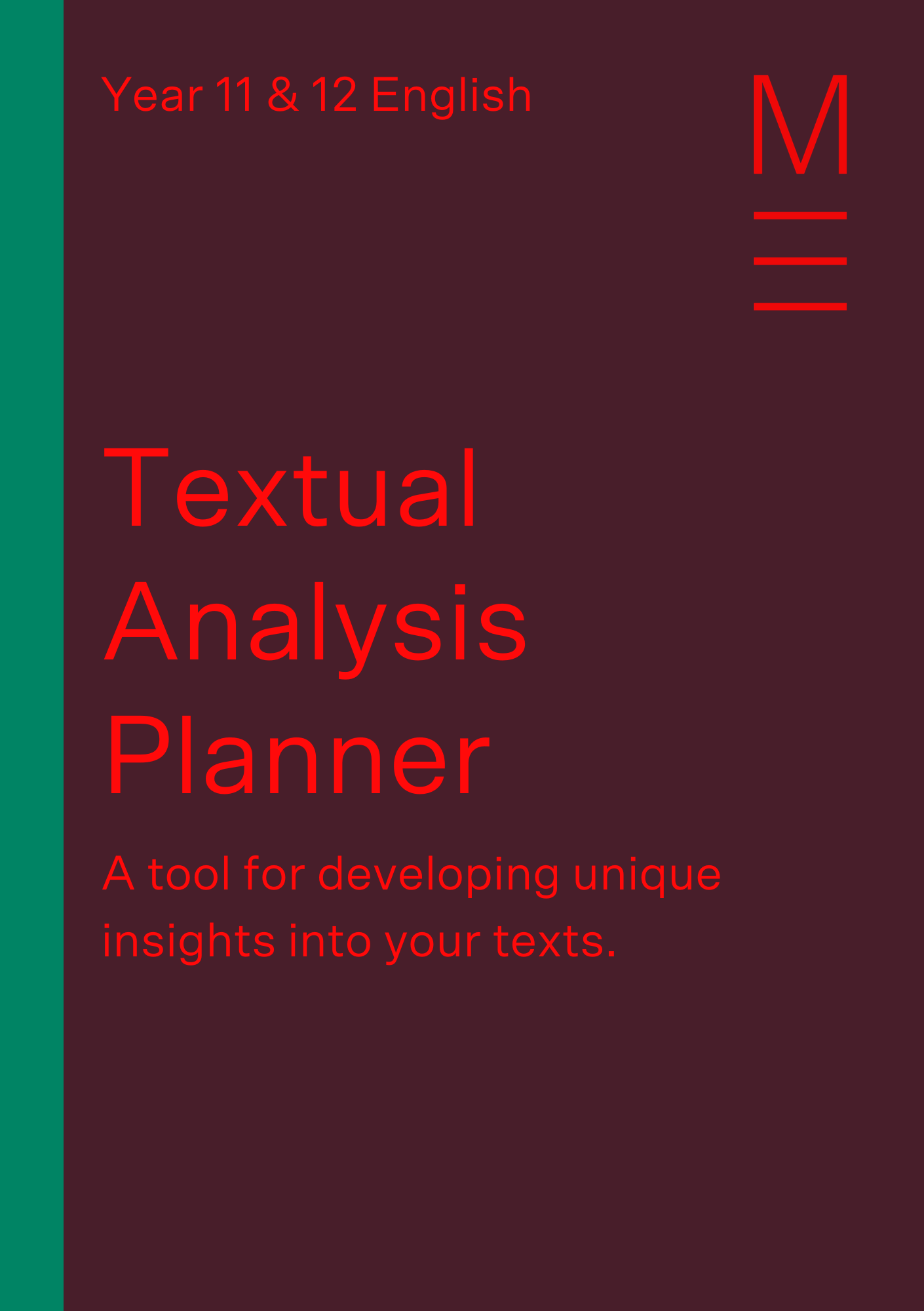
Download your free English Textual Analysis Planner
Learn how to analyse texts and produce insightful notes!
Your Planner is on the way! Cheque your e-mail for the downloadable link. (Please let a few minutes for your download to land in your inbox)
DOWNLOAD YOUR Gratis TEXTUAL Analysis PLANNER
Why do and so many students discover textual analysis difficult?
You lot, like many students, might feel that textual analysis sounds ominously overwhelming, broad, and vague. But it shouldn't be. Why?
There is a process for reading and analysing your English texts.
It's mainly due to students non adopting the right process for reading and analysing English language texts. Consequently, many students experience the following bug:
- Failing to appoint with their texts.
- Struggling to produce adequate and useable notes.
- Difficulty writing essays that respond to the Stage 6 Outcomes or the Module requirements because they haven't "read" their texts in the well-nigh effective manner.
What is "reading" and what are "texts"?
When we discuss "reading" we mean the process of engaging with a text. This can include viewing a film or reading a novel or looking at a picture. As we appoint with it, we effort to understand the meaning it contains. This is a process of analysis that we generally refer to every bit "reading."
Keeping thorough and attainable study notes is a very of import part of reading a text. After you have read the text, you need to notation down your findings. Y'all will apply these notes as the ground for your responses. Does this sound familiar?
The procedure of making and keeping notes for English is similar to noting down the results of an experiment.
Similarly, when we speak of "texts" for English, we hateful a wide variety of text types (what NESA sometimes refers to as the medium of product) including (merely not limited to): novels, novellas, non-fiction writing, brusk stories, graphic novels, comics, images, plays, poems, films, telly serial, and websites. Each text type will crave a detail arroyo to reading it, as things like plot, characters, and ideas are rendered differently in different mediums of production.
What is the process I should use for reading and analysing English texts?
The process of reading and analysing texts is something that often gets taken for granted in the school classroom. You need to read, or view, your texts in order to empathise them. Then you have to translate your reading into critical analysis of the texts' meaning. Then yous need to collate this insightful assay into practical and constructive notes.
At Matrix, nosotros teach our students the following procedure:
- Stride 1: Reading or Viewing a Text for Themes and Ideas.
- Pace 2: Making First Circular of Basic Notes.
- Step iii: Read Your Text a 2nd Fourth dimension to Identify Ideas / Themes.
- Step 4: Read Your Text a tertiary Time to Identify Examples and Techniques.
- Footstep 5: Tabulate Your Notes.
Let'south discuss each step of the procedure in detail.
The process for textual analysis
Step 1: Reading or viewing a text for themes and ideas
Reading a text for study is a multi-step procedure. To extract the most information out of a text in the shortest corporeality of fourth dimension, students should follow a logical procedure.
Let's have a await at the procedure involved:

Learn how to analyse texts like a pro
At Matrix, nosotros provide you with clear and structured lessons, quality resources, and personalised, effective feedback from Matrix teachers.
Learn more about our Year 12 English Advanced Matrix Course now.
So, what does this entail? Permit'due south have a look at the specifics of reading a text:
i. Read the text for the first time – This may hateful reading the book or watching the movie set for study. The kickoff fourth dimension you engage with a text should exist to enjoy information technology and understand what is happening in information technology. You want to understand what the plot is nigh and who the characters are.
2. Write down your initial observations and feelings well-nigh the text – Jot downward whether you liked the text. Note down what y'all think it is about and how it relates to your Module.
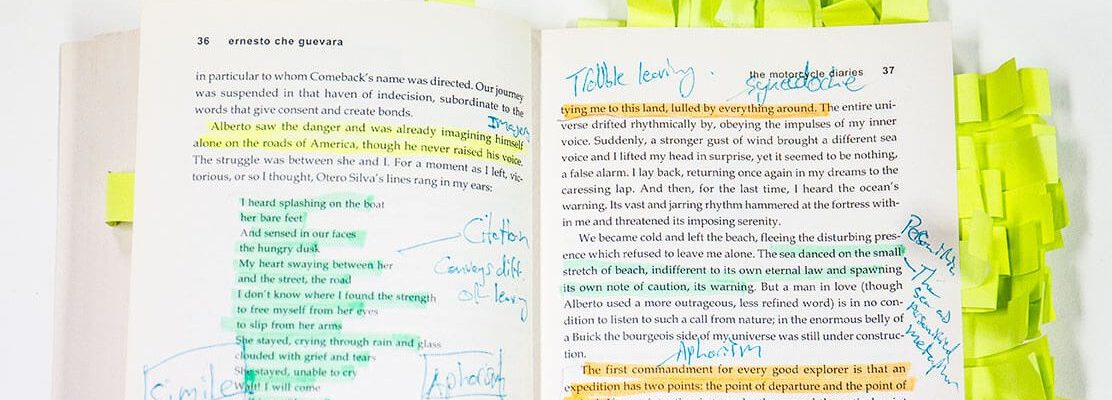
Don't worry if your annotations become messy.
iii. Read the text a 2d time – This is when y'all should begin making notes. Underline and highlight important sentences and phrases in poems, plays, non-fiction texts, and novels. Make notes nearly scenes in films. This step is very important because it is where you outset unpicking how the composer has developed pregnant.
4. Brand notes – Now you've read the text twice, you should be able to kickoff identifying the themes in the text.
The notes you brand are very of import, you'll use these to write your essays and responses.
Write down answers to the following questions:
- What are the prominent ideas in the text? – These are your key themes.
- Who are the significant characters?
- What are their roles?
- What are their characteristics?
- How practice these characters embody the ideas in the text?
- What are the characters' narrative arcs?
- How are the characters' experiences resolved or concluded? – Analysing a character's evolution in a text volition aid y'all sympathise a composer'south perspective on a theme.
5. Read the text a third time– This reading is where you develop your understanding of the text. You must go through the text looking for where an thought is best represented. While yous may have underlined or highlighted large swathe of your text on the second reading, the third reading is where you will be able to see what is actually relevant to your study of the text. When you lot observe an example that conveys the detailed meaning that is relevant to your written report of the text, you should write it down and make notation of the technique.
What if my text isn't a motion picture or novel?
Some text types may crave a slightly dissimilar approach.
Do y'all need specific help with analysing poetry?
You should read our web log post, How To Analyse A Poem In 6 Steps!
Has reading Shakespeare left you stumped?
You should read our step-by-pace blog post on How to Analyse Shakespeare.
Step ii: Making notes
Now that we've discussed reading texts, we need to expect at making notes. A student's notes volition develop with each successive reading of the text. For example,
- 1st Reading – A wide understanding of the text – its plot, characters, and setting.
- 2d Reading – A developing agreement of its cadre ideas, an agreement of character development, lots of examples underlined or highlighted in your texts or detailed notes of visual texts.
- 3rd Reading– Detailed notes about ideas. Each ane of these key ideas is a theme. You want to organise the examples from your texts effectually these themes. When you do your 3rd reading, yous should annotation how specific examples from your text reverberate its fundamental ideas. You must make notes as you become, as you want to proceed track of the insights you accept while engaging in analysis.We've looked at how to read and how to beginning organising your ideas and examples. Only sometimes it is difficult to know what ideas are worthwhile. Similarly, it can be difficult figuring out which example is worth utilising and incorporating into your notes.
Allow'due south take a look at how to spot the key ideas in a text.
Back to Summit
Footstep 3: Identifying ideas / themes
Understanding the plot and following what happens to the characters in the text is 1 matter, merely agreement the ideas that these convey is an birthday different i.
When nosotros refer to "themes" we actually mean the central ideas in the text.
Ofttimes we refer to ideas as themes because they are common to a number of texts, but also whole genres or selections of art and literature. Knowing the genre of the text yous are studying will requite yous hints as to what sort of themes you should look for. For example, a Gothic text will have themes of death, decay, and secrets. Even if you know roughly what themes volition be in a text, you nonetheless need to place them.
Here are some practical approaches you can take:
1. Consider the plot– Enquire yourself what the key ideas in the plot are. For instance, is information technology about two people who are in honey? And so love is a theme.
Does the plot involve people trying to notice things? Discovery is a theme.
Do characters have trouble knowing if they are beingness told the truth or manipulated? The rift between advent and reality is a theme.
two. Look at the characters' positive and negative qualities – The characters' flaws are often the substance of the ideas the composer is trying to convey. Nosotros can await to a characters' narrative arc to see what ideas are in a text.
For instance, InOthello, the main characters are very proud and jealous. Pride and jealousy are key ideas in the play. We encounter these qualities reflected in the characteristics of other characters in the play, also.
InNineteen Lxxx-Four, the main character, Winston, and his lover, Julia insubordinate against the government. We can say resistance is a central idea in the text.
3. Look for recurring symbols in the text – A recurring symbol, or motif, can embody a key idea in a text.
For example, InBlack Swan, Nina'due south character has to perform the roles of the Black and White Swan from Swan Lake. She has to be two opposing characters – pure and innocent and powerful and provocative – at the same time. We can say that dualism is a key theme in the text.
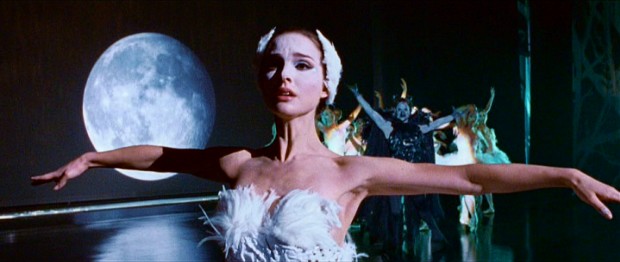
Image: Aronofksy'due south Nina as the White Swan looks vulnerable and uncertain
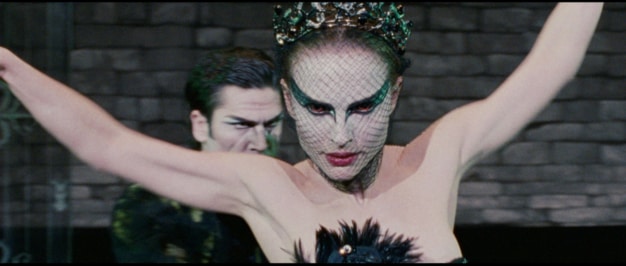
Paradigm: Aronofksy's Nina as the Black Swan looks confident and predatory
Similarly, InThe Great Gatsby, many characters are bad drivers. This is symbolic of how out of control society is. We can say that personal responsibleness is a primal theme.
4. Consider the ideas that are explicitly stated in a text – Sometimes composers are very straight with the ideas they experience are important in a text. They might discuss these ideas at length in the text – either direct or in the conversations that characters have. For example,
- In theHandmaid's Tale, Offred speaks explicitly nigh her proper noun and the character she has to play in Gilead. This means that identity is a key theme in the text.
- In The Motorcycle Diaries, Che writes at length virtually the dissever between rich and poor and how he perceives this as being unfair. He is discussing the theme of class difference.
At present that we've identified some themes, we need to think near gathering evidence. Let's look at some strategies for identifying testify.
Back to Top
Step 4: Identifying examples and techniques
Essays for Phase half-dozen must be evidence-based. This means that students must provide examples from the text to back up their arguments. They must so discuss how the techniques in those examples develop a sure meaning or reinforce a theme.
One of the difficulties students face is identifying examples and the techniques in them. Unfortunately, this is a skill that must be learned and practised rather than solved with a quick tip or fix.
To be effective at identifying techniques, students must be aware of a wide range of literary/ dramatic/ poetic/ filmic techniques and their various applications.
That method looks like this:
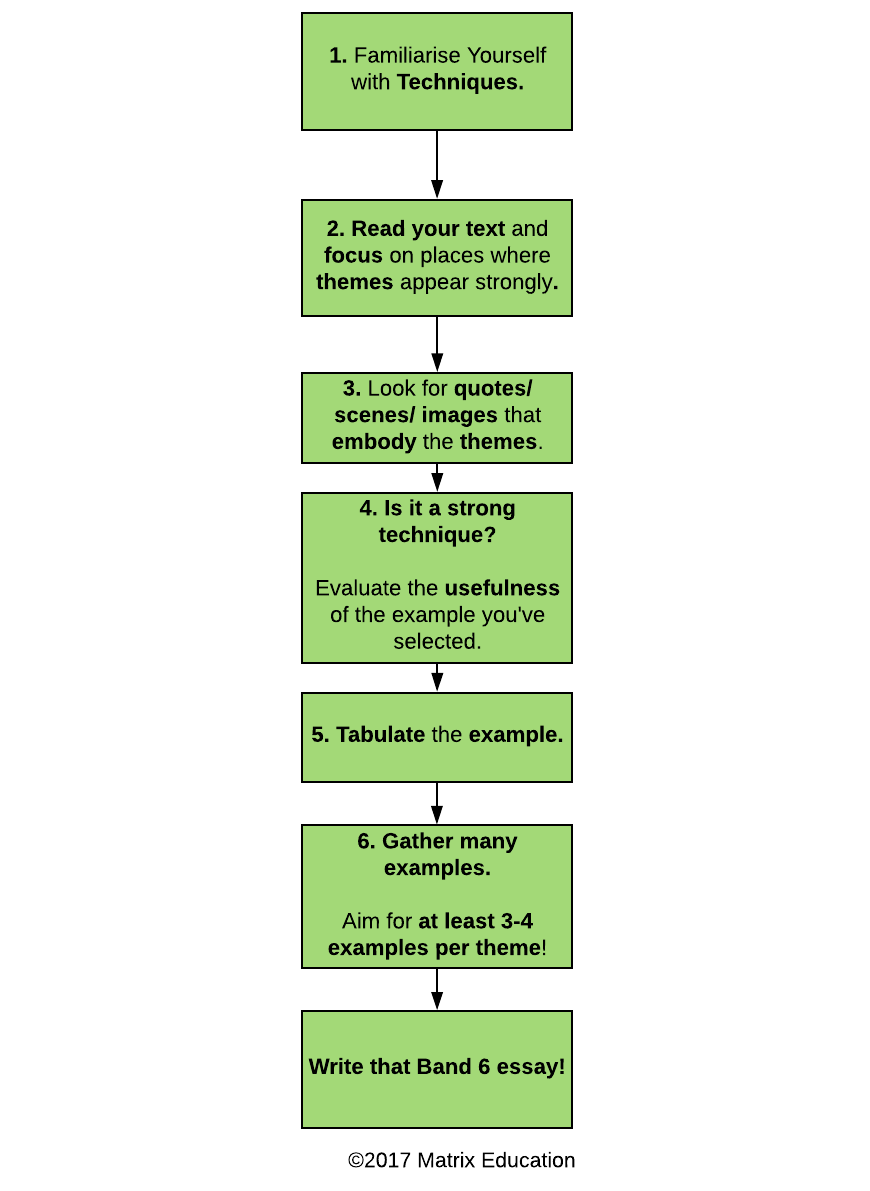
Flowchart: How to Identify Examples and Techniques
1. Familiarise yourself with the specific techniques the texts medium of production uses. You can find a list of literary techniques and their effects here and here. You tin find a list of filmic techniques hither. Information on analysing poetry can be constitute here.
2. Read or view your text, focusing on places where the thematic ideas y'all are interest seem most prominent and visible.
3. Look for quotations, scenes, or images that seem to embody the thought that you are concerned with. These will be the parts of the text that you lot accept highlighted in your text or fabricated notes about.
4. Try to rate the value of the technique that the quotations are using. Not all techniques are equal. If y'all have a pair of adjacent quotations and one uses alliteration (three words in a row starting time with the same letter – "she studies solidly and scored an A on her physics examination") and the other is a metaphor (it makes something into something else – "she was a gun in the physics exam and got an A"), and then the metaphor is going to convey the idea with more strength and clarity.
Similarly, in picture show, a two-shot (a shot that places ii characters in the same shot to testify a human relationship) volition exist less effective than a selective focus shot (where a 2-shot switches the focus from character to another without panning or moving the photographic camera to demonstrate a change in the human relationship between the characters). A general dominion to follow is:
The more than complex the process of representing, the more effective the technique is for your argument.
five. Make notation of the instance and its technique in your table. You must ensure that you can chronicle the examples you have chosen to the concerns you need to hash out. The more detailed you can be in your notes, the more you will exist able to elaborate on your points in an essay.
six. Get together as many examples as you tin can. You will use these to populate your tabular array with. It is worth remembering that some examples will be suitable for several themes or ideas in your text.
For some units such equally Module A or Module B, analysing and identifying techniques will not be enough. You will besides demand to discuss context or critical views. this means you volition need to appoint in some research. Let'due south have a await at how to become most this.
Back to Top
Step 5: Tabulate your notes
Making tables is the nearly efficient way to produce study notes for English. The principle backside making tables is to extract all of the relevant information from a text and place it in an easy to access document.
When you prepare for exams or write exercise essays, you don't want to be fishing through novels for quotations or skipping through films for the appropriate scene. Instead, yous desire to be able to find the instance you demand every bit quickly and only as possible. This is what tables are for.
Allow's expect at an case of a study table:
| A Sample Study Table For English Notes | |||||
| Theme/ Graphic symbol | Example | Technique | Effect | Enquiry | |
| What to practice | Organise your notes past theme or character | Provide a quotation or case from the text. | Note and draw the technique used. | Explain how the technique affects or shapes your understanding of the meaning in the example. | Await for what others say about this theme or example from the text? Try to expect for scholarly articles. Wikipedia is a good place to begin research, but it is not e'er reliable or accurate. After reading a Wikipedia article, you should look at its sources and read those articles. Ofttimes Wikipedia articles included suggested further reading, these are ideal places to further continue your research. We discuss Wikipedia and other research resources in Chapter iii of this guide. Make notation of your findings and keep track of the references. |
| Example | "The Difficulty of Yr 11" | Year 11 English is similar scaling Mount Everest. | The use of "similar" signifies this is a simile. | This simile compares Yr 11 English to climbing a large mountain. This argues that Year 11 is hard and requires a lot of careful preparation. | 25th June: Lots or people agree that Year 11 English is difficult. Some say that universities require to study specific units of English and achieve specific marks. I should look into why that is to develop my notes further. 26th June: The Matrix weblog states that "The English Advanced Modules are more complex and enervating than the English Standard Modules." (https://www.matrix.edu.au/english-studies-vs-english-standard-vs-english-advanced) |
| Example From Othello | Iago's Villainy | Iago: And what's he so that says I play the villain? / When this advice is free I give and honest (ii.iii. 330-331) | Rhetorical Question (hypophora – asks a question and immediately answers information technology). | Iago is giving them logical and helpful communication. The use of hypophora is a manipulative technique. Answering the question he'south asked immediately means that Iago's listeners aren't given time to formulate an answer against it. | 24th June: Not sure why Iago is evil? 26th June: Found a quote by R.Berry: "This is of the aforementioned order every bit the grotesquely exaggerated hell-imagery in his speeches, which nosotros should not take at face-value. Iago, in truth, likes to think of himself as evil, as the villain: he plays the role in capital letters." Berry argues that Iago revels in his villainy and his concealment of it. (R. Berry 1972. http://www.jstor.org/stable/2868648) |
The above table has five important columns:
- Theme/ Character: the key idea, or the character y'all are focusing on.
- Example: The quotation or a description of the scene yous are using.
- Technique: The technique(due south) nowadays in the example. Information technology might be useful to ascertain the technique if it is non a common one.
- Effect: Explain the outcome of the technique – discuss how information technology develops the meaning you see in the quotation.
- Research: Get online and offset looking for the appropriate information for your module. Yous may need to detect contextual information for Module A, or disquisitional perspectives for Module B.
Back to Top
© Matrix Teaching and world wide web.matrix.edu.au, 2022. Unauthorised use and/or duplication of this material without express and written permission from this site's author and/or owner is strictly prohibited. Excerpts and links may exist used, provided that total and clear credit is given to Matrix Pedagogy and www.matrix.edu.au with appropriate and specific direction to the original content.
Source: https://www.matrix.edu.au/beginners-guide-to-acing-hsc-english/how-to-analyse-english-texts/
0 Response to "There Are Three Ways to Read Any Text for Analysis"
Post a Comment